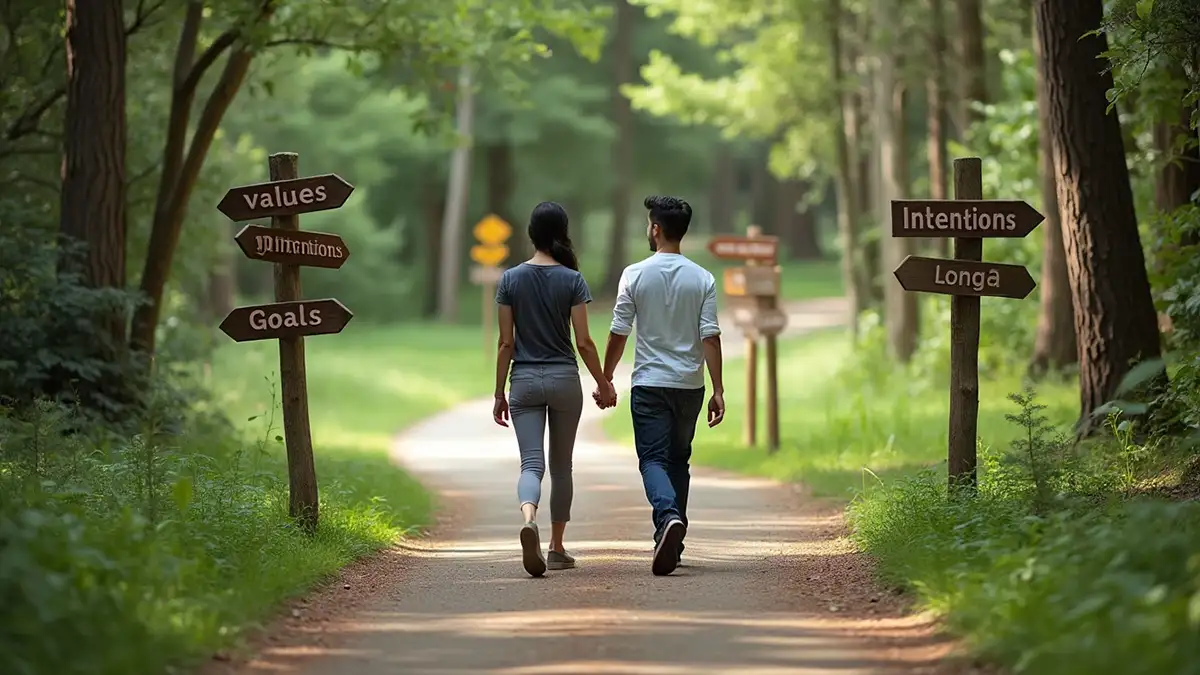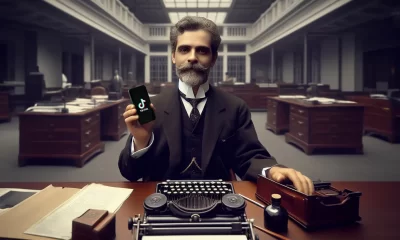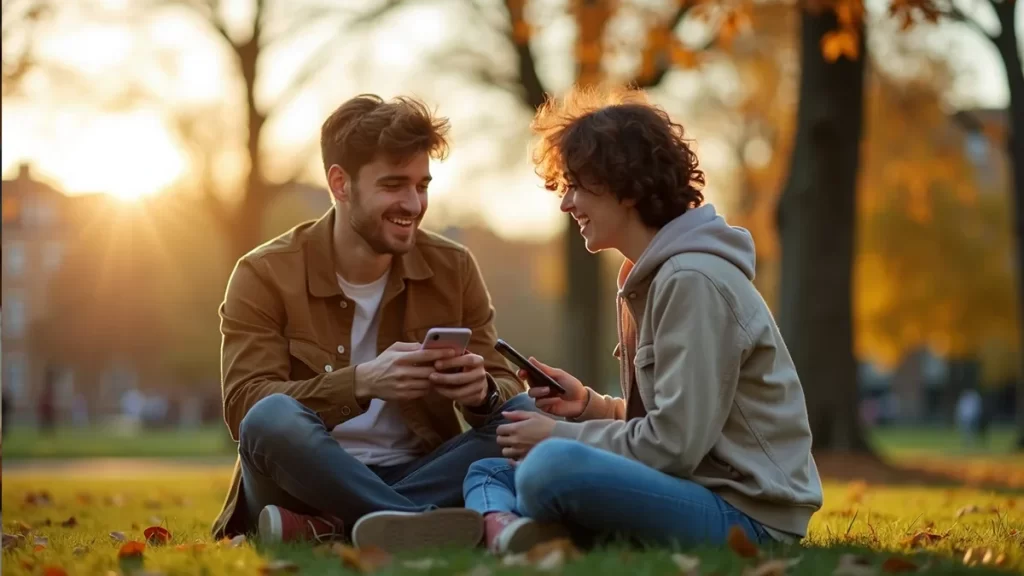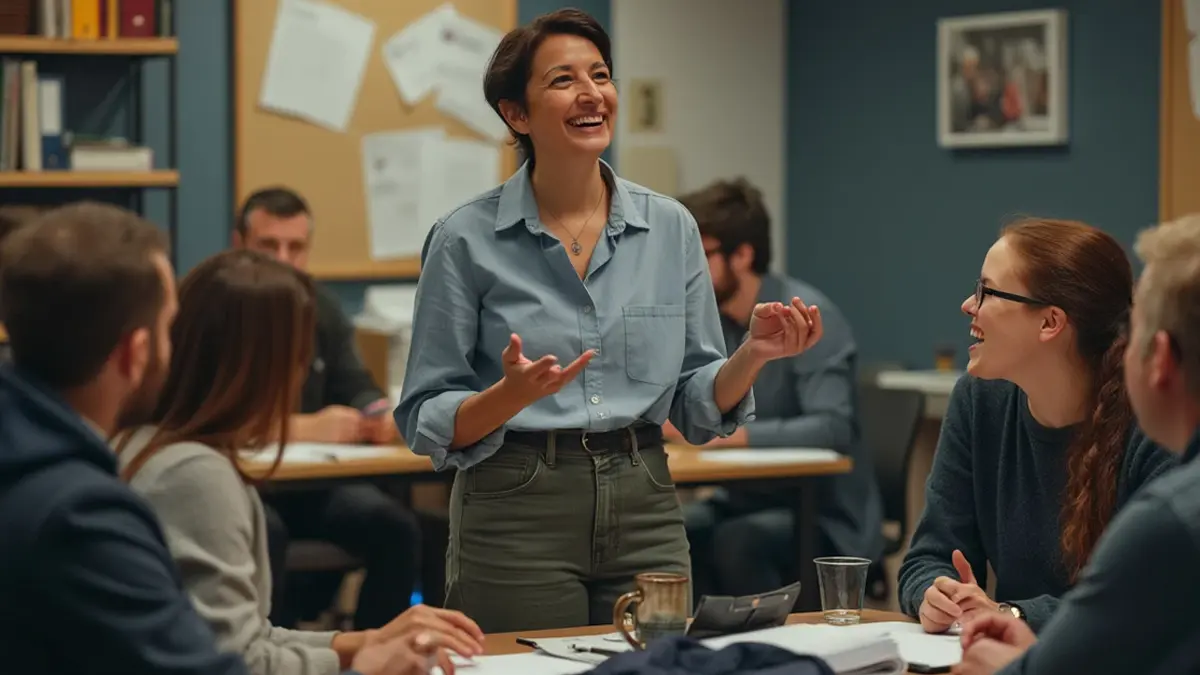3 Conscious Dating Practices: Building Healthy Relationships with intention

The Importance of Conscious Dating
In today’s fast-paced world, relationships can sometimes feel like a whirlwind. But here’s the thing: if you’re looking for something real, something that lasts, then conscious dating might be just what you need.
Instead of just going with the flow, conscious dating is all about being intentional. It’s about knowing what you want, sticking to your values, and making sure your actions match your long-term goals.
“When you date with intention, you’re not just hoping for a good relationship—you’re building one with purpose.” — Dr. Emily Richards, relationship expert
By practicing conscious dating, you’re setting yourself up for a relationship that’s not just surface-deep but built on respect, shared values, and genuine connection. And let’s be honest, who doesn’t want that?
In this article, we’ll dive into what it means to date consciously, how to build relationships mindfully, and why using intentional dating strategies can lead to a love that truly lasts.
Table of Contents
Key Concepts: Understanding Conscious Dating
Conscious dating isn’t just a trendy phrase—it’s a way of life. At its heart, conscious dating means being fully aware of your values, goals, and what you’re looking for in a relationship.
Think of it like setting a compass before you start your journey. You’re not wandering aimlessly; you know where you’re headed, and you’ve got a clear idea of what matters most.
One key part of this is mindful relationship building. Instead of rushing in, take a step back. Get to know the person you’re dating. What are their values? Do they line up with yours? Are they someone who’ll support your dreams and respect your boundaries?
“Before you can build a lasting relationship, you need to be sure the foundation is solid.” — Dr. John Chapman, relationship therapist
Another piece of the puzzle is using intentional dating strategies. This means being clear about what you want from the start. No beating around the bush. Set your boundaries, have honest talks, and make sure you’re both on the same page.
When you combine these elements, you get a solid approach to conscious dating—being true to yourself while finding someone who respects that.
Practical Applications: How to Practice Conscious Dating
So, how do you bring conscious dating into your life? First, know what truly matters to you.
Take a moment to reflect on your core values, your dreams, and what you want in a partner. This is your roadmap, guiding you through the dating world.
Next, focus on mindful relationship building. Slow down and get to know the person. Ask the right questions, observe how they treat others, and see if their values align with yours. This isn’t about playing detective—it’s about making sure you’re on the right path.
“Dating is a journey of discovery. Take your time to see if your paths truly align.” — Dr. Helen Parker, dating coach
Lastly, embrace intentional dating strategies. Be upfront about what you’re looking for. If you want something serious, say so. If certain things are deal-breakers, make them known. This way, both parties are clear, and there’s no guessing game.
Remember, each date should bring you closer to someone who fits your values and long-term goals. Conscious dating is about finding someone who fits into the bigger picture of your life.
Case Studies: Real-Life Examples
Example 1: Sarah’s Intentional Journey
Sarah knew she wanted a partner who shared her faith and family values. When she started dating, she made her intentional dating strategies clear from the start.
“By setting clear boundaries, I found someone who respected my values and shared my vision for the future.” — Sarah, on her conscious dating experience
She wasn’t interested in casual flings; she was looking for something lasting. Being upfront helped her find a partner who was on the same page, and now they’re building a life together.
Example 2: Tom and Lisa’s Mindful Connection
Tom and Lisa didn’t rush into things. They practiced mindful relationship building from the very beginning, taking time to ask deep questions and understand each other’s values.
“We made sure we were aligned before making any commitments, which has only strengthened our relationship.” — Tom and Lisa, on their mindful approach to dating
Their thoughtful approach helped them build a relationship that’s not only strong but deeply connected.
Challenges and Solutions: Overcoming Obstacles
Conscious dating sounds great, but it’s not always easy. Here are some challenges and solutions:
Challenge 1: Fear of Rejection
Being upfront about your expectations can be scary. What if they don’t feel the same way? But honesty from the start saves heartache later. If someone’s not on the same page, it’s better to know early.
Challenge 2: Finding Like-Minded People
It can be tough to find someone who shares your values. But don’t settle—be patient. Quality always beats quantity, and the right person will come along.
Challenge 3: Pressure from Society
Society often pushes us to settle for less or act in ways that don’t align with our values. Conscious dating is about what’s best for you, not what others think. Stick to your values, and the right person will respect that.
Expert Insights: The Benefits of Conscious Dating
Experts agree that conscious dating leads to more fulfilling and successful relationships. According to Dr. Henry Cloud, couples who share core values are more likely to have lasting, happy relationships.
“Relationships built on shared values have a stronger foundation for long-term success.” — Dr. Henry Cloud, relationship expert
Studies also show that couples who practice mindful relationship building experience deeper emotional intimacy and satisfaction.
Conclusion: Embrace Conscious Dating for a Better Future
Conscious dating isn’t just about finding someone to spend time with—it’s about finding someone to build a life with. By focusing on mindful relationship building and using intentional dating strategies, you’re creating the opportunity for a deeper, more meaningful connection.
“When you date consciously, you’re not just looking for love—you’re building a partnership that can stand the test of time.” — Dr. Amy Sinclair, relationship psychologist
Take the time to reflect on your values, communicate openly, and don’t settle for less than what you deserve. Conscious dating can lead to a healthy, fulfilling relationship built to last.
Personal Reflection: Evaluate Your Dating Practices
- What are your core values, and how do they guide your dating choices?
- Are you practicing conscious dating by being clear and intentional about what you want?
- How can you incorporate mindful relationship building into your relationships?
Share Your Conscious Dating Experiences
We’d love to hear about your experiences with conscious dating! Share your stories and tips in the comments below or join the conversation on social media using #ConsciousDating.
Finding Balance: The Art of Saying No Without Guilt

Have you ever felt overwhelmed because you said “yes” to something you really didn’t want to do? Saying no without guilt can be tough, and it happens to the best of us.
Sometimes, we find ourselves agreeing to things out of fear—fear of letting someone down, of missing out, or of being seen as selfish. But what if learning to say “no” could actually be one of the most powerful things you do for yourself?
Table of Contents
The Weight of the Word “Yes”
It all starts with a simple word: “yes.” It’s such a small word, yet it can carry so much weight. I remember a time when I was saying “yes” to everyone—my friends, my family, my coworkers.
Every time someone needed a hand, I was there, ready and willing, even if it meant staying up late, giving up my weekends, or putting aside my own needs.
It seemed like I was being helpful, but in truth, I was crumbling under the pressure.
I realized I was losing myself under the pile of promises I had made to others. I would go to bed exhausted, feeling like I hadn’t done a single thing for myself.
Slowly but surely, I understood that my problem wasn’t just time—it was boundaries. I needed to learn the art of saying “no” without carrying the crushing weight of guilt.
The Guilt Trap: Why Is Saying No without guilt is So Hard?
Saying “no” can feel like you’re letting someone down. And isn’t that the worst feeling? It’s like telling a friend that you can’t help them move or turning down extra work from a boss who trusts you.
It feels selfish, like you’re closing a door on someone who’s counting on you.
But here’s the thing: every time you say “yes” to something you don’t want, you’re actually saying “no” to yourself. You’re saying “no” to your rest, to your hobbies, to the quiet moments you need just to be.
And when you keep putting yourself last, you start to feel that gnawing sense of frustration and burnout—because, deep down, you know you deserve better.
“Saying ‘no’ isn’t about pushing people away. It’s about creating space for what truly matters, for both you and the people who need you most.”
The Power of a Well-Placed “No”
There’s power in the word “no.” It’s not just a rejection—it’s a redirection. It’s telling the world that your time and energy are precious, and that you know exactly where you want to focus them.
Saying “no” can be freeing. It can be an act of courage, a promise to yourself that your needs matter just as much as anyone else’s.
I remember the first time I said “no” to a big request. A friend had asked me to help plan a huge event—a project that would take weeks of my evenings and weekends. I almost said yes out of habit, but I caught myself.
I realized that I needed this time for me. I politely told my friend that I couldn’t commit this time, and, to my surprise, she understood. She even thanked me for being honest. It felt like a weight lifted from my shoulders.
“No” doesn’t have to be harsh. It can be gentle, kind, and full of respect—both for yourself and for others.
How to Say “No” Without the Guilt
Learning to say “no” takes practice. It’s not about being rude or uncaring, but about setting healthy boundaries. Here are some ways you can say “no” while still feeling good about it:
- Be Honest, But Kind: You can say, “I wish I could help, but I just don’t have the time right now.” This shows you care, but you also have limits.
- Offer an Alternative: If you can’t say yes, offer another way to help, like suggesting someone else who might be available or offering to help at a different time.
- Keep It Simple: You don’t have to explain everything. A simple “No, I can’t take that on right now” can be enough. The more you justify, the harder it becomes.
- Remember Your Priorities: Ask yourself, “If I say yes, what am I saying no to?” Keeping your own needs and goals in mind can make it easier to decide.
Setting Boundaries Is Self-Care
When you say “no,” you’re not only protecting your time; you’re also setting an example for others. You’re showing them that it’s okay to put yourself first sometimes.
This kind of self-care is like building a wall—not to keep people out, but to make sure that what comes in is what you truly want.
Think of it like a garden. You need boundaries to keep out the weeds so that the flowers—the things that bring you joy—can grow. If you let everyone trample through it, eventually, the flowers will wither, and you’ll be left with a patch of dirt. Boundaries allow you to nurture the beauty in your life.
“Boundaries aren’t walls; they are gates that let the right things in and keep the harmful things out.”
Conclusion: Finding Balance in Life
So, the next time someone asks you for something, take a moment. Don’t rush into a “yes” out of habit or guilt. Pause and ask yourself if this is something you can and want to do.
Remember, saying “no” doesn’t make you a bad person. It makes you someone who knows the value of their time, energy, and well-being.
Now, I’d love to hear from you. What’s one thing you wish you could say “no” to more often? Let’s start practicing together. You deserve the peace that comes from creating healthy boundaries—one “no” at a time.
Millennials vs. Gen Z: 11 Simple Ways to Show Appreciation

Why Showing Appreciation Matters Across Generations
No matter your age, feeling appreciated is like a warm hug—it just feels good. Whether you’re a Millennial juggling work and family or a Gen Z navigating school and social media, finding simple ways to show appreciation can strengthen your connection with others.
It’s not about grand gestures, but rather small, meaningful actions that let people know you value them. Taking a moment out of your day to express gratitude, whether through a thoughtful message or spending quality time, can make all the difference in building and nurturing relationships.
“Appreciation is the foundation of any lasting relationship, no matter the generation.” – Dr. Emily Roth, Relationship Expert
Both Millennials and Gen Z value appreciation, but how they give and receive it can differ. Millennials tend to appreciate personal, face-to-face interactions. Gen Z, on the other hand, often turns to digital platforms to show their gratitude.
So while the methods to show appreciation might differ, the core message stays the same: it’s all about making the other person feel valued.
11 Simple Ways to Show Appreciation to Your Loved Ones
“The act of expressing gratitude, no matter how small, strengthens bonds and builds trust.” – John Howard, Relationship Coach
1. Write a Heartfelt Note
Millennials might remember the days of handwritten notes—folded neatly and tucked into a friend’s locker. They love putting pen to paper to express their gratitude. A handwritten letter can feel personal, thoughtful, and long-lasting.
Gen Z, however, often prefers a digital touch. A sweet, well-written text message or a beautifully crafted Instagram post might be their go-to. The platform might change, but the heart behind the appreciation remains the same.
2. Give Them Your Undivided Attention
“In today’s fast-paced world, offering your full attention is one of the most sincere gifts you can give.” – Psychology Today
Sometimes, showing appreciation means just being present. Millennials might put their phones away during dinner, offering undivided attention as a way to show they care.
Gen Z might express appreciation through digital means—like sharing a video chat or sending a specially curated playlist. The key is giving time and focus, whether in person or online.
3. Surprise Them with a Thoughtful Gift
When it comes to gifts, Millennials tend to favor artisanal, nostalgic items like a personalized mug or vintage records that evoke memories.
Gen Z is more likely to go for trendy, modern items, like limited-edition sneakers or a digital subscription to their favorite app. For both generations, the key is picking something that shows you’ve been paying attention to what makes the other person smile.
“The best gifts don’t have to be expensive—they just need to show you care.” – Erica James, Gift Giving Expert
4. Cook Their Favorite Meal
Millennials often show appreciation by cooking their loved one’s favorite meal. A homemade lasagna or perfectly grilled steak can speak volumes without saying a word.
On the other hand, Gen Z might opt to order their loved one’s favorite takeout or send a food delivery. It’s still about knowing what they love and making sure they enjoy it, no matter how it arrives.
5. Give a Compliment
A well-placed compliment can brighten anyone’s day. Millennials often offer verbal praise like, “You did an amazing job!” or “That looks great on you!” They value face-to-face expressions of appreciation.
Gen Z, however, may post a shout-out on social media or drop a fire emoji under a picture to show they’re paying attention. Different delivery, same impact.
6. Help Them with Something They’ve Been Putting Off
“Acts of service can be one of the strongest demonstrations of love.” – Gary Chapman, Author of The 5 Love Languages
Sometimes, the best way to show appreciation is by offering help. Millennials might offer hands-on assistance, like helping you move or clean the garage.
Gen Z might offer remote help—organizing files on Google Drive or whipping up a shared doc for collaboration. Both generations show they care by making your life a little easier.
5 Reasons Why Storytelling in Communication is Essential for Engaging Audiences

Ever noticed how a good story can captivate you from the first sentence? That’s no accident. Storytelling in communication has become a powerful tool for engaging audiences and conveying messages effectively.
Whether you’re a business professional, a marketer, or a leader, understanding how to use narratives can significantly enhance your ability to connect with others.
In today’s world, where people are bombarded with information, stories cut through the noise. They resonate on a deeper level, making complex ideas more relatable and memorable.
As a result, professionals are increasingly recognizing the value of storytelling in communication to make their messages stick.
Let’s explore why storytelling is such a powerful communication tool and how you can use it to make your interactions more impactful.
Table of Contents
Why Storytelling is a Powerful Communication Tool
At its core, storytelling in communication works because it taps into something fundamentally human. Stories have been a part of our culture for centuries, helping us make sense of the world and share experiences. But why do they work so well?
One reason is that stories engage the brain differently than plain facts or data. When we hear a story, our brains don’t just process the information—we live it. We visualize the scenes, feel the emotions, and even empathize with the characters. This deep engagement makes stories memorable and helps the message stick long after the story is over.
Another key aspect of storytelling is its ability to simplify complex ideas. When you wrap information in a narrative, it becomes easier to understand and relate to.
This is particularly important in fields like marketing, education, and leadership, where the goal is to make an impact quickly and clearly.
By using storytelling in communication, you can create a strong emotional connection with your audience. This connection is what drives action, whether it’s making a decision, embracing a new idea, or simply remembering what you’ve said.
The Science of Storytelling: How It Engages the Brain
There’s more to storytelling in communication than just engaging content. Science backs up why storytelling is so effective. When we hear a story, our brains release chemicals like oxytocin, which promotes empathy and trust, and dopamine, which helps with memory and attention.
When you tell a story, you’re not just sharing information; you’re activating multiple parts of your audience’s brain. This includes areas responsible for sensory experiences, emotions, and motor functions. In other words, a well-told story can make your audience feel like they’re living the experience themselves.
This deep level of engagement leads to better retention of information. People are more likely to remember stories than a list of facts or bullet points. This is why storytelling in communication is so effective in teaching, marketing, and leadership—it turns abstract ideas into tangible experiences.
Moreover, storytelling can create a shared experience, fostering a sense of connection between the storyteller and the audience.
This connection can make your message more persuasive and impactful, helping you to influence others and drive action.
Practical Ways to Incorporate Storytelling into Your Communication
Now that we understand why storytelling in communication is so powerful, let’s look at how you can start using it in your daily interactions.
1. Start with a Relatable Character
Every good story needs a character that your audience can connect with. This could be you, a customer, or even a fictional character that embodies the challenges and goals your audience faces. The key is to make the character relatable and engaging.
7 Reasons Why Random Acts of Kindness Are More Powerful Than You Think

Have you ever held the door open for a stranger or offered a compliment, only to find it brightened your day just as much as theirs?
These simple gestures are what we call random acts of kindness, and they’re becoming more popular as people realize just how impactful they can be.
In a world where negativity often grabs the headlines, these small acts of kindness can create a ripple effect of positivity.
Whether it’s paying for someone’s coffee or simply sharing a smile, these gestures don’t just benefit the receiver—they also uplift the giver.
Let’s explore why random acts of kindness are more powerful than you might think, and how you can easily incorporate them into your daily life.
Table of Contents
The Psychology Behind Kindness: Why It Feels So Good
Ever wondered why performing random acts of kindness feels so good? It turns out, there’s some fascinating psychology behind it.
When you do something kind, your brain releases a cocktail of feel-good chemicals, including serotonin, oxytocin, and endorphins.
Serotonin is often referred to as the “happy hormone,” and it plays a crucial role in boosting your mood. When you perform an act of kindness, your brain produces more serotonin, making you feel more content and fulfilled.
Oxytocin, sometimes called the “love hormone,” is released when you connect with others through kind actions. It fosters a sense of bonding and trust, which can strengthen relationships and build a sense of community.
And let’s not forget about endorphins, the body’s natural painkillers. These chemicals are released during acts of kindness, leading to what’s often called a “helper’s high”—a rush of happiness that makes you want to keep spreading positivity.
By performing random acts of kindness, you’re not just making someone else’s day brighter; you’re also enhancing your own well-being in a meaningful way.
The Ripple Effect: How Kindness Spreads
One of the most incredible aspects of random acts of kindness is their ability to spread far beyond the initial gesture.
When you do something kind, it often inspires the recipient to pass it on, creating a chain reaction that can ripple through communities and even across the world.
Imagine you start your day by buying a coffee for the person behind you in line. That small act could inspire them to hold the door open for someone else, who might then go on to help a colleague at work.
Before you know it, your single act of kindness has sparked a series of positive actions.
This ripple effect isn’t just hypothetical—it’s backed by research. Studies have shown that when people witness or experience kindness, they’re more likely to engage in kind behaviors themselves. This means that your small gesture can lead to a much larger impact than you might expect.
In workplaces, communities, and even online, random acts of kindness can create an environment where positivity thrives. It’s a powerful reminder that even the smallest actions can have a profound effect.
-

 Personal Growth & Mindset5 months ago
Personal Growth & Mindset5 months agoTed Lasso Effect: 5 Goal-Setting Secrets You Must Know
-

 AI & Future Trends10 months ago
AI & Future Trends10 months agoAI in Time Management 2024: A New Era of Productivity for Business Leaders
-

 Personal Growth & Mindset6 months ago
Personal Growth & Mindset6 months agoMachado de Assis: This Viral TikTok Explains Why You Need to Read ‘The Posthumous Memoirs of Brás Cubas’ Now
-

 Career & Success11 months ago
Career & Success11 months ago30 Key Strategies for Growth: Mindset, Productivity & Wellness
-

 Career & Success6 months ago
Career & Success6 months agoChallenges of Not Having Goals: 5 tips to help you get started
-

 Personal Growth & Mindset11 months ago
Personal Growth & Mindset11 months agoBreaking Free from the Shackles of Bad Habits: 5 books to help you

























Pingback: Keeping the Spark Alive: 5 Long-Distance Relationships Tips - Growth Journey Hub
Pingback: Building Resilient Relationships: Strengthening Bonds in Challenging Times - Growth Journey Hub
Pingback: Mastering Cultural Competence: Navigating Cross-Cultural Communication in 2024 - Growth Journey Hub
Pingback: 3 Essential Relationship Non-Negotiables and Boundaries - Growth Journey Hub